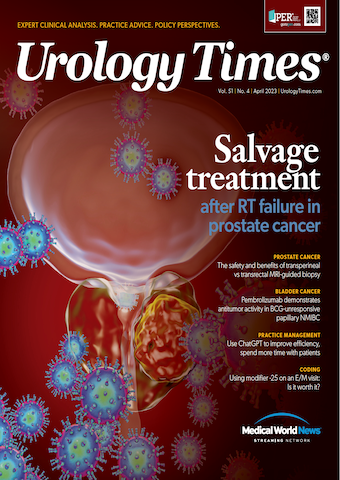Publication
Article
Urology Times Journal
FDA approval sought for niraparib/abiraterone tablet for BRCA+ mCRPC
Author(s):
The application is supported by findings from the phase 3 MAGNITUDE study.
A new drug application (NDA) has been filed with the FDA for use of niraparib (Zejula) combined with abiraterone acetate (Zytiga) in a dual-action tablet (DAT) plus prednisone as a treatment for patients with BRCA-positive metastatic castration-resistant prostate cancer (mCRPC).1
“Patients with mCRPC and BRCA mutations face a more aggressive form of prostate cancer and high unmet needs in terms of treatment options," said Peter Lebowitz, MD, PhD.

Janssen (Johnson & Johnson), the developer of the DAT, reported in a press release that its NDA is supported by findings from the phase 3 MAGNITUDE study, which showed that adding the PARP inhibitor niraparib to the antiandrogen agent abiraterone significantly extended radiographic progression-free survival (rPFS) in patients with mCRPC and homologous recombination repair (HRR) gene alterations, such as BRCA1/2.
Data presented during the 2022 Genitourinary (GU) Cancers Symposium showed that compared with placebo plus abiraterone, niraparib plus abiraterone led to a 47% reduction in the risk of progression or death in patients with BRCA1/2 mutations and a 27% reduction in the risk of progression or death in all patients with HRR gene alterations.2 The median follow-up time was 18.6 months.
In the BRCA1/2 population, the median rPFS was 16.6 months with niraparib plus abiraterone vs 10.9 months with placebo plus abiraterone (HR, 0.53; 95% CI, 0.36-0.79; P = .0014). The investigator-assessed rPFS was 19.3 months with niraparib/abiraterone and 12.4 months with placebo/abiraterone (HR, 0.50; 95% CI, 0.33-0.75; P = .0006).
Among all patients with HRR gene alterations, the median rPFS was 16.5 months vs 13.7 months, respectively (HR, 0.73; 95% CI, 0.56-0.96; P = .0217). Here, the investigator-assessed rPFS was 19.0 months and 13,9 months, respectively (HR, 0.64; 95% CI, 0.49-0.86; nominal P = .0022).
“Patients with mCRPC and BRCA mutations face a more aggressive form of prostate cancer and high unmet needs in terms of treatment options. The data supporting this submission reinforce the importance of biomarker testing to identify the subgroups of patients that are most likely to respond to a targeted treatment option," Peter Lebowitz, MD, PhD, global therapeutic area head, Oncology, Janssen Research & Development, LLC, stated in the press release. "This submission further represents our commitment at Janssen to discover and develop precision medicine approaches and combination therapies to help improve outcomes for patients living with genetically defined disease."
The study enrolled patients with mCRPC who had received no more than 4 months of prior abiraterone and prednisone for mCRPC; had an ECOG performance status of 0 or 1; and had a Brief Pain Inventory-Short Form worst pain score of 3 or less. Eligible patients were screened for HRR alterations in ATM, BRCA1, BRCA2, BRIP1, CDK12, CHEK2, FANCA, HDAC2, and PALB2.
Based on prescreening results, patients were allocated into the biomarker-positive cohort or the biomarker-negative cohort, which had a planned enrollment of 400 and 600 patients, respectively.
Patients were randomized 1:1 to receive 200 mg of niraparib once daily plus abiraterone or placebo plus abiraterone in each of the cohorts.
Regarding baseline characteristics, the median age was 69 years (range, 43-100). In the niraparib and placebo arms, respectively, 23.6% (n = 50) and 22.7% (n = 48) of patients had prior abiraterone/prednisone, 24.1% (n = 51) and 18.5% (n = 39) had visceral metastases, and 46.3% (n = 98) and 43.6% (n = 92) had BRCA1/2 mutations.
Notably, the addition of niraparib to abiraterone prolonged time to initiation of cytotoxic chemotherapy (HR, 0.59; 95% CI, 0.39-0.89; P = .0108), time to symptomatic progression (HR, 0.69; 95% CI, 0.47-0.99; P = .0444), and time to PSA progression (HR, 0.57; 95% CI, 0.43-0.76; P = .0001) in all patients with HRR gene alterations.
In terms of safety, no new signals were seen. All-grade treatment-emergent adverse effects (AEs) occurred in 99.1% (n = 210) of patients in the niraparib arm vs 94.3% (n = 199) of patients in the placebo arm. The most common all-grade AEs in the niraparib arm were anemia (46.2%; n = 98), hypertension (31.6%; n = 67), and constipation (30.7%; n = 65). The most common AEs in the placebo arm were hypertension (22.3%; n = 47), anemia (20.4%; n = 43), and fatigue (16.6%; n = 35).
Sixty-seven percent (n = 142) of patients in the niraparib arm experienced grade 3/4 AEs vs 46.4% (n = 98) of patients in the placebo arm. The most common grade 3/4 AEs in the niraparib arm were anemia (29.7%; n = 63), hypertension (15.6%; n = 33), and thrombocytopenia and neutropenia (each, 6.6%; n = 14) vs hypertension (14.2%; n = 30), anemia (7.6%; n = 16), and hepatotoxicity (4.7%; n = 10) in the placebo arm.
Dose reductions occurred in 19.8% (n = 42) of patients on niraparib with a median relative dose intensity of 99%. The most common AEs leading to dose reduction in the niraparib arm were anemia (13.2%) and thrombocytopenia (2.8%).
Additionally, 10.8% (n = 23) and 4.7% (n = 10) of patients discontinued treatment in the niraparib and placebo arms due to AEs, respectively. Deaths due to an AE occurred in 11 (5.2%) of patients on niraparib vs 7 (3.3%) of those on placebo.
Notably, no clinically significant differences in overall quality of life were seen between the study arms, according to results from The Functional Assessment of Cancer Therapy-Prostate questionnaire.
Updated data
Updated MAGNITUDE data with an additional 8 months of follow-up were shared by Eleni Efstathiou, MD, PhD, at the 2023 GU Cancers Symposium.3
With the additional follow-up, the median radiographic rPFS was 16.7 months in the niraparib group vs 13.7 months in the placebo arm (HR, 0.76; 95% CI, 0.60-0.97; nominal P = .0280). Niraparib also yielded a statistically significant benefit in time to symptomatic progression (TSP) vs placebo, with a hazard ratio of 0.60 (95% CI, 0.42-0.84; P = .0029), as well as in TCC, with a hazard ratio of 0.67 (95% CI, 0.47-0.94; P = .0206).
Among patients with BRCA alterations, the median rPFS was 19.5 months and 10.9 months in the niraparib and placebo arms (HR, 0.55; 95% CI, 0.39-0.78; nominal P = .0007), respectively. TSP progression in the BRCA subgroup was not evaluable (NE) in the niraparib arm vs 23.6 months in the placebo (HR, 0.54; 95% CI, 0.35-0.85; P = .0071). Additionally, the TCC in the BRCA subgroup was NE in the niraparib arm and had a median of 27.3 months in the placebo arm (HR, 0.56; 95% CI, 0.35-0.90; P = .0152), respectively.
Niraparib treatment also resulted in a delayed time to worst pain intensity (HR, 0.70; 95% CI, 0.44-1.12; nominal P = .1338) and pain interference (HR, 0.67; 95% CI, 0.40-1.12; nominal P = .1275) in the BRCA subgroup vs placebo.
“We all acknowledge that patients with metastatic CRPC and HRR alterations, especially BRCA [alterations], have a grim prognosis,” Efstathiou, a medical oncologist and section chief of Genitourinary Medical Oncology at Houston Methodist Cancer Center in Texas, said during her presentation. “Here, with a longer median follow-up…the MAGNITUDE trial confirms the benefit of the niraparib plus abiraterone combination, with a 45% reduction in the risk of progression or death and an extension of median rPFS to more than 1.5 years…compared with placebo plus abiraterone.”
Researchers from the MAGNITUDE trial are continuing to collect data, including for the key secondary end point of overall survival.
References
1. Janssen Submits New Drug Application to the U.S. Food and Drug Administration Seeking Approval of Niraparib and Abiraterone Acetate Dual-Action Tablet, Plus Prednisone, as a First-Line Targeted Treatment for Patients with Metastatic Castration-Resistant Prostate Cancer with BRCA Gene Mutations. Published online and accessed March 1, 2023. https://prn.to/3SI7rvF
2. Chi KN, Rathkopf DE, Smith MR, et al. Phase 3 MAGNITUDE study: first results of niraparib (NIRA) with abiraterone acetate and prednisone (AAP) as first-line therapy in patients (pts) with metastatic castration-resistant prostate cancer (mCRPC) with and without homologous recombination repair (HRR) gene alterations. J Clin Oncol. 2022;40(suppl 6):12. doi:10.1200/JCO.2022.40.6_suppl.012
3. Efstathiou E, Smith MR, Sandhu S, et al. Niraparib with abiraterone acetate and prednisone in patients with metastatic castration-resistant prostate cancer and homologous recombination repair gene alterations: second interim analysis (IA2) of MAGNITUDE. J Clin Oncol. 2023;41(suppl 6):170. doi:10.1200/JCO.2023.41.6_suppl.170

































